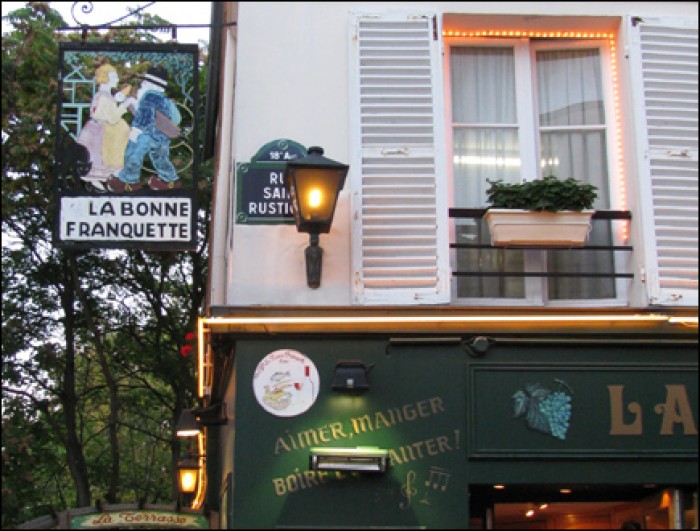
Montmartre celebrated its annual Grape Harvest Festival (Fête des Vendanges) in early October with a series of joyful community events including lectures, concerts, tasting events, a parade, and more in a local celebration of an area affectionately known locally as the Republic of Montmartre.
The event is at once a celebration of community and folklore and of course wine in the wide neighborhood that, unsuspecting to most first-time visitors to Montmartre, lies just beyond Sacré Coeur and the tourist scene on Place du Tertre.
In 1932 a third-of-an-acre plot on the northern face of the hill of Montmartre was usurped by City Hall and planted with vines as both a reminder of Montmartre’s winegrowing history and as a way of preventing a developer from taking over the lot. Baptized Clos Montmartre, the vines are primarily gamay with some pinot noir and a few hybrid vines thrown into the mix.
Two smaller vine plots in this, the 18th, arrondissement also get attention during the festival: Clos Bretonneau, a part of Hospital Bretonneau, located across the street from Montmartre Cemetery, and a handful of vines in the Ruisseau Gardens near Porte de Clignancourt. However it is Clos Montmartre, by the corner of Rue des Saules and Rue Saint Vincent, across the street from the old cabaret Le Lapin Agile, that stands as the declaration of independence of the Republic of Montmartre and as the excuse for Montmartre’s annual Grape Harvest Festival since 1934.
Wine auction
In addition to its celebration of all things Montmartre, the festival is also the occasion to raise money for local causes. What better way then to raise funds than through a wine auction—not of the wines of Clos Montmartre (a doubtful production but by all accounts improving) but by wines from around France donated for the occasion. Auction items formed a wine lover’s tour de France: Alsace, Burgundy, Corsica, Provence, Languedoc, Bordeaux, Jurançon (southwest) and much from the Rhone Valley. A bottle of Clos Montmartre (ostensibly priced at 45 euros) was given with each lot of auctioned wine.
The auction took place this year at La Bonne Franquette, located just uphill from the vineyard and one of the many restaurant/wine halls that earned Montmartre its reputation as a place the party in late 19th-century Paris. La Bonne Franquette’s motto, written on its façade is “Aimer, Manger, Boire & Chanter” – Love, Eat, Drink & Sing.
The charity wine auction is by invitation only, which may explain why the atmosphere was rather subdued, with few mounting bids. Nevertheless, under the hammer of auctioneer Pierre Cornette de Saint-Cyr and with wine commentary provided by Enrico Bernardo, winner of Best Sommelier in the World in 2004, and Thierry Desseauve, co-author of Le Grand Guide des Vins de France, and the encouragement of Brigitte Houdinière, president of the 18th arrondissement’s Events and Social Actions Committee, about 8500 euros was raised for local charities.
Afterwards donors, auctioneers, several attending winemakers who’d contributed bottles for the auction, and assorted others were invited to stay for dinner.
La Bonne Franquette
The term à la bonne franquette is loosely translated as “eating simply, without ceremony” but further indicates a relaxed meal among friends. One can certainly eat well à la bonne franquette, as we did that evening, but one does so without expecting gastronomy or formality.
A sign on the façade of La Bonne Franquette indicates that Pissaro, Sisley, Degas, Cezanne, Toulouse-Lautrec, and others once frequented the joint (without ceremony) and that its garden is depicted in a painting called “La Guingette” by Van Gogh, now in the Orsay. That could well make this a tourist restaurant of the most basic sort, yet La Bonne Franquette, under the management of Patrick Fracheboud since 1980, maintains a kind of easy-going authenticity and a folksiness that’s only partly contrived, along with an extensive wine list.
Part bistro, part cabaret, part garden dance café, part wine bar (next door), the atmosphere is at once a post-Impressionist artifact and a place to “eat simply, without ceremony,” “have a relaxed meal among friends”—and why not “love, eat, drink & sing” too!
For the post wine auction dinner we were served a Jurançon to accompany the foie gras, a Muscadet to accompany the haddock and Champagne-doused choucroute, a Fleurie to accompany the beef stew au Beaujolais, and a sparkling Montlouis to accompany the candied chestnut, … and an accordionist to accompany us in song. Well, not all of us were French enough to know the words.
© 2010, Gary Lee Kraut
La Bonne Franquette, corner of 2 rue des Saules and 18 rue Saint Rustiques, 18th arrondissement. Tel. 01 42 52 02 42.www.labonnefranquette.com. Metro Abbesses or Lamarck Caulincourt. Open daily for lunch and dinner. Patrick Fracheboud also operates the restaurant Les Noces de Jeannette, 14 rue Favart, 2nd arrondissement.
Montmartre Tourist Office, official site: www.montmartre-guide.com.
Montmartre Grape Harvest Festival, Fête des Vendanges: www.fetedesvendangesdemontmartre.com.

